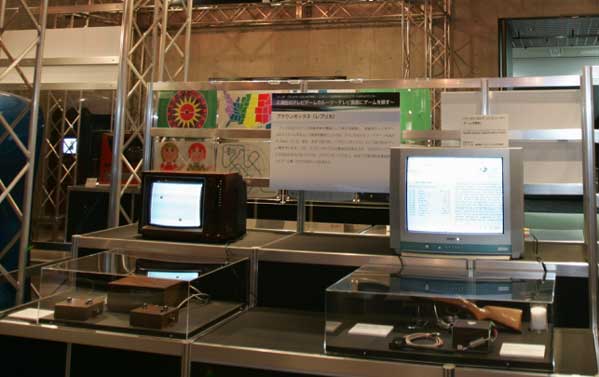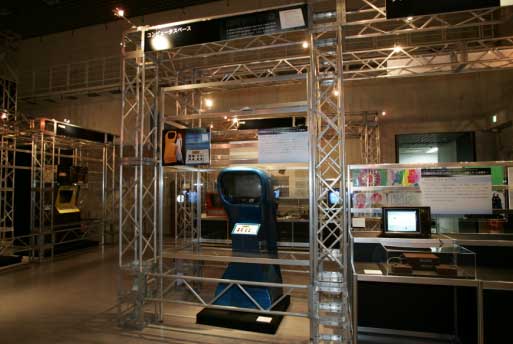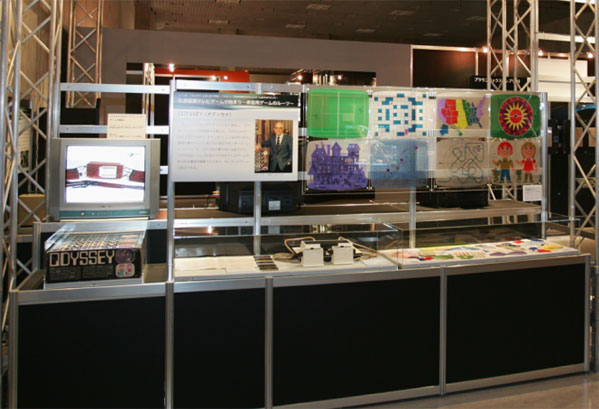Videogames
are extremely popular in Japan. Their foremost science
museum recently presented a half-year-long exhibit
dedicated to the industry's history. A large number
of original games were on display. The presence of
some of the earliest games addressed the history of
both the home videogame and that of the arcade games.
At
the Tokyo museum, the well-attended exhibit of early
videogames closed after a successful 6-month run there.
A look at the photo of the entrance to the game exhibit
is shown nearby.
Visitors
approaching the Entry Arch were greeted with this
message on the top line:
"The Story of the Beginning
of Videogames"
Straight ahead as you enter is the front portion of
a display table featuring the "Brown Box",
the prototype for the earliest commercial home video
game, the 1972 Magnavox "Odyssey"
multi-game system.
In
the photo, the Brown Box can be seen through
the Arch on the left side of the display table. As
accompanying signs tell the visitor, the Brown Box
was the last of seven developmental game systems designed
and built by Ralph Baer in 1967-1968. His original
concept of playing games on ordinary TV sets and developing
the required technology with the help of two engineers
made home videogames practical. Resultant patents
and know-how were licensed to Magnavox. The Brown
Box became the Magnavox Odyssey game system.
Which started the home video game industry. It was
first sold to the public in 1972. Over 350,000 Odyssey
found their way into in US homes within two-and-a-half
years, introducing well over a million people to the
idea of playing games on a TV screen.
The
Brown Box played a variety of games as did
the Odyssey game system. Among these were Ping-Pong,
Handball and Volleyball. It was the Ping-Pong
game that most people played and still associate with
early videogames, aided and abetted by the popularity
of the Nolan Bushnell's Atari Pong game that
came into widespread distribution in 1973.

ENTERING
THE EXHIBIT DEDICATED TO VIDEOGAME HISTORY IN TOKYO
In November of 1972, the same year during which the
Odyssey introduced people to the idea of home videogames,
Atari began delivering the first commercially successful
arcade videogame, Pong. An original Pong arcade game
displayed to the left of the Brown Box. Pong was wildly
successful and put the arcade videogame industry on
ther map. Pong games were almost instantly copied
by other manufacturers. By the end of 1973 about fifty-thousand
Atari, Midway, Seeburg Pong-like arcade machines were
sold in the U.S. alone.
The
Entrance Hall photo above and the picture of the display
table shown below also displayed an earlier game system,
TV Game #3. It is the small unit at the right
side of the display table. TV Game #3 offered a choice
of chase games (one player "spot" chasing
another and wiping it out on contact) and a light
gun target shooting game.
The
monitor located on the right of the display table
presented a short movie featuring a demonstration
of both games systems by Ralph Baer. The large sign
at the center describes the genesis of TV Games and
of the Brown Box in particular.

The
monitor above the Brown Box displayed the basic Ping-Pong
game that was its central attraction.
The
large sign at the center of the table says:


Nolan
Bushnell's Computer Space arcade game which was
manufactured by Nutting Associates and started the
arcade videogame industry was featured right next
to Baer's Brown Box exhibit. The long view of the
exhibit entrance above shows the blue Computer Space
game console as well as the yellow Atari Pong
game at the far left,
The
rear of the Brown Box display table is shown below.
It features an Odyssey and its colorful, transparent
screen overlays.

The
large sign at the rear of this Odyssey display table
shows Ralph Baer with an Odyssey game box in 1972.
The text briefly details the chronological history
of home videogames.
On
a nearby wall, the pages from Ralph Baer's original
September 1966 Disclosure Documents and a picture
of the Brown Box were displayed. The sign above the
row of documents says: "Ralph Baer's Brown
Box"

POSTSCRIPT
The
Tokyo exhibit at their National Science Museum presented
a brief but accurate snapshot of the beginnings of
the videogame industry. Anyone really interested in
the history of home videogames and the details of
Ralph Baer's part in that saga can get much insight
from his website at <www.ralphbaer.com>
and reading "The Story of how Videogames invaded
the Home TV set" or by reading his book, "Videogames:
In the Beginning".

E-Mail
to order
a copy of this fantastic book
ONLY
$29.99
